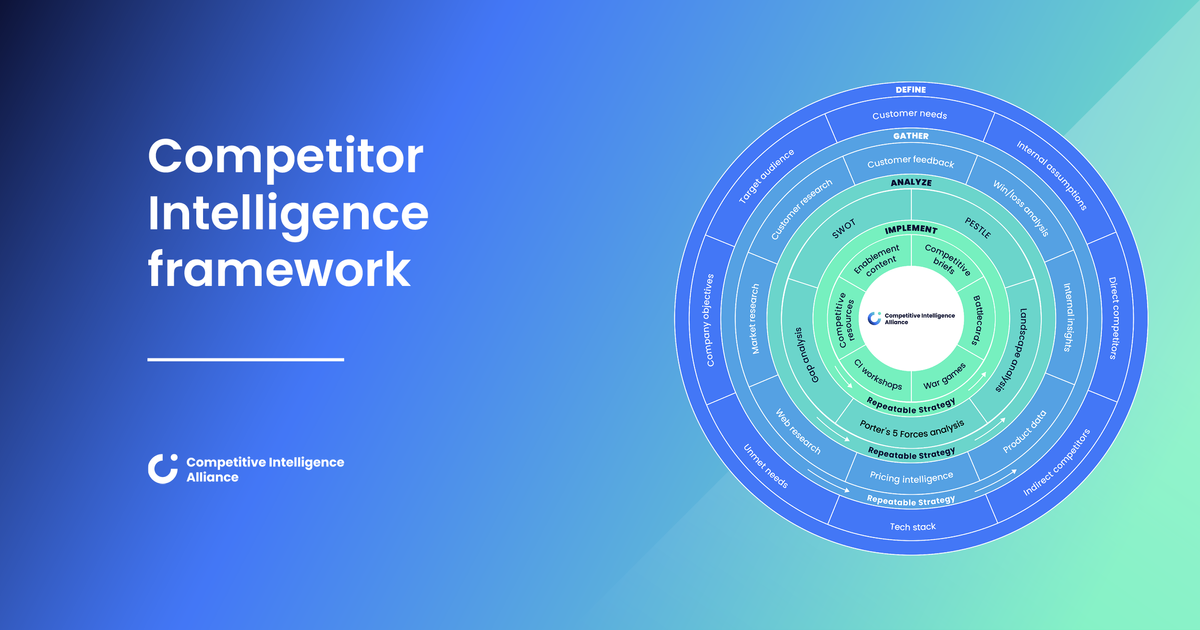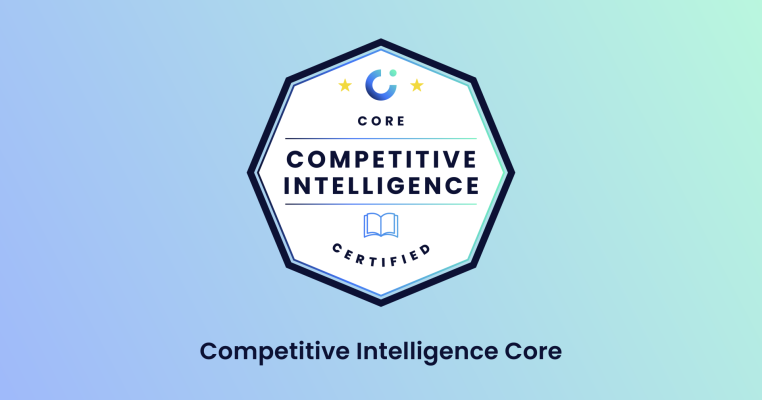As markets grow ever more competitive, keeping a close eye on your competition is no longer a luxury – it's a necessity. While your sales teams are likely already equipped with competitive battlecards, there's a group that can make even greater use of competitive insights: the C-suite.
According to the Competitive Intelligence Trends Report 2022, while a whopping 92.6% of respondents reported sharing competitive intelligence (CI) with sales teams, only 73.5% did the same with their executives or leadership.
Meanwhile, the State of Competitive Enablement Report 2022 reveals that for a mere 2.2% of CI pros, C-suite executives are primary users of the intel they gather – surprising when you consider the impact CI could have on strategic decisions and long-term growth.
Yet, delivering CI to the C-suite can create the most long-term value. Andy Vale, Product Marketing Manager at Infinity, observes:
“More recently, [CI] has been looked at more from a strategic level nearer the top of the business. This level can overestimate the importance of certain trends or features, but is the area I feel competitive intelligence would be most useful in the long term.”
The icing on the cake? If you can successfully demonstrate the value of CI to those holding the company’s purse strings, you might just find it easier to secure more resources, budget, and tooling.
So, let’s delve into some best practices for sharing CI with the C-suite. We’ll also uncover the art of crafting a competitive intelligence report, common pitfalls you should avoid when delivering CI to leadership, and other tips and tricks that'll help you unlock the strategic potential of CI.
Best practices for sharing CI with leadership
Navigating the busy schedules of C-suite executives can often feel like a high-stakes game of Tetris. Yet, the importance of delivering effective competitive intelligence to this strategic powerhouse cannot be overstated. So, how can you ensure your intel lands not just in their inbox, but also on their action list?
- Keep your briefs brief: Execs are elite multi-taskers, juggling dozens of demands every day. So, your CI briefs should be just that – brief. Aim for a succinct summary that gets straight to the heart of the matter.
- Align with their goals: Want your competitive intel to pack a punch? Tailor it to your executives’ goals and priorities. Don't just throw in every piece of intel you have. Sift through the data and focus on those insights that could potentially move the needle on their strategic objectives.
- Timing is of the essence: In the ever-changing business landscape, information grows stale faster than you can say “competitive intelligence.” If you're reporting on a development that unfolded weeks ago, chances are your execs have either already caught wind of it, or the window of opportunity has closed. Make it your mission to provide timely, relevant intel that facilitates swift and strategic decision-making.
- Don't just deliver data – offer insight: Raw data might be a competitive intelligence analyst's best friend, but for busy executives, it's about as helpful as a traffic jam on the way to a crucial meeting. They don't just need data; they need insights. Transform the raw information into clear and actionable recommendations that help your executives respond effectively to competitive developments.
- Embrace open dialogue: The best CI brief is a living document – one that sparks conversation, facilitates decision-making, and evolves with your business. Encourage your execs to provide feedback on your briefings, and ensure there's a quick and easy way for them to comment or respond to your insights. This ongoing dialogue will not only improve your CI delivery but also help you build trust and rapport with the C-suite.
By adhering to these best practices, you can ensure that your competitive intelligence not only reaches the executive suite but also helps drive strategic decision-making. After all, CI isn't just about knowing your competition; it's about leveraging that knowledge to stay ahead of the pack.
• How to deliver competitive intelligence to sales and customer success
• How to deliver competitive intelligence to your marketing teams
• How to deliver competitive intelligence to your product, design, and engineering teams
How to write a competitive briefing your execs will actually read
Distilling complex data into a digestible, actionable briefing for your executives is an art form in itself. Let’s take a look at how to get it done right, plus a simple template to help you hit the ground running.
First things first, your point of view should sit loud and proud at the very top of your document. Don't bury it under heaps of data or preamble. Rather, capture it succinctly in your headline. For instance, you might say, “We regard Company X as a tech partner and an indirect competitor” – straightforward and to the point.
Next, delve into the rationale. Here's where you provide the ‘why’ behind your point of view. Let's say your data shows that when customers invest in Company X’s product, they tend to spend more time on its interface than yours. That's important intel, so share it.
You might also note, “Even with increased usage of XYZ's interface, customers still lean on our product as the ultimate source of truth. There's been no significant customer revenue churn due to Customer X’s presence in their account.” Be clear, be concise, but most importantly, be relevant.
Your executives will want to understand the competitive landscape too. So, if the competitor's product and user interface closely mirror yours, share this insight. Highlight key differences: “Yes, customers could perceive us as direct rivals. Yet, they fall short in resolving these three critical issues.” A comparison of this nature is invaluable in helping the executive team see where you stand.
Always remember, though, it's not just about drawing comparisons. It's about carving a path forward. So, in your report, suggest potential responses to customer queries about the competitor. For instance, “If a customer brings up XYZ, we can acknowledge them as a tech partner but also highlight that we provide most of their offerings. They might have a few extra bells and whistles, but our core services align.”
Here's a handy template you can use to structure your report:
- Headline: We regard [company] as a tech partner / indirect competitor / direct competitor / aspirational competitor / replacement competitor*.
- Rationale: Key data points that back up your headline.
- Comparison: How the competitor compares with your company or product.
- Implications: How the competitor's actions could potentially impact your business.
- Recommendations: Concrete actions that your company should consider in response.
*Psst! Want to know more about the different types of competitors? Check out Head-to-Head: The Competitive Intelligence Playbook.
Consider this your roadmap to a progressively detailed viewpoint about a potential competitor. It's all about serving up the most valuable, actionable insights in a package that respects your executive's time and attention.
Looking for next steps?
Competitive intelligence is a powerful growth lever for any organization... if done right.
There are many concepts to master if you're to satisfy your customers, motivate your team, and optimize your workflows.
Enter our Competitive Intelligence Framework. 🏁
It covers everything you need to know to navigate the competitive intelligence cycle, from start to finish.

Common pitfalls of delivering CI to the C-suite
Let's delve into the common pitfalls of delivering competitive intelligence to your leadership team and, more importantly, how we can sidestep these obstacles.
Pitfall #1: Time constraints
We’ve already alluded to this, but it bears repeating: executives are perpetually caught in a time crunch. They’re racing against the clock to meet deadlines, attend meetings, and drive strategic initiatives. Your in-depth, painstakingly researched CI report? It's competing with a lot of other priorities.
Solution: Keep it concise. Deliver a succinct summary with your key points and recommendations right at the top. This allows them to get the gist at a glance, and delve deeper if time permits.
Pitfall #2: Bias
Sometimes, the hardest part isn't delivering the information – it's overcoming preconceived notions or biases. An executive might be inclined to ignore or discount insights that contradict their beliefs about their company’s standing in the market.
Solution: Present a fair and balanced view, with data-driven arguments to back up your claims. Be prepared for a healthy debate, and remember, it's not about proving who's right – it's about finding the truth.
Pitfall #3: Getting them to read it
You can draft the most insightful, data-rich report, but if they don’t read it, it might as well not exist.
Solution: Meet them where they are. If they live on Slack, deliver your insights on Slack. If they're email aficionados, craft a compelling email. If they're dashboard devotees, create a live dashboard they can access as and when they need to.
Pitfall #4: Information overload
With a sea of information at their fingertips, executives can easily become overwhelmed. This information overload can lead to analysis paralysis, where making decisions becomes difficult.
Solution: Curate carefully. Instead of throwing everything you have at your leaders, be judicious about the insights you share. Highlight the most critical data points that tie into their strategic goals.
Pitfall #5: Disconnected data
CI reports often present data in silos, without demonstrating how different elements interconnect or influence one another. This could lead to a fragmented understanding of the competitive landscape.
Solution: Connect the dots. Show the bigger picture and how different data points relate to each other. By providing a comprehensive view of the situation, you’ll aid better decision-making.
In short, delivering competitive intelligence to your leaders in the C-suite is all about respect – respect for their time, their current workflows, and their need for concise, connected, unbiased information. Dodge these common pitfalls and your competitive intelligence will become an indispensable tool for your executives.
Key takeaways
Delivering competitive intelligence to busy executives can seem daunting, but with a pinch of empathy, a splash of strategy, and a healthy dollop of clarity, it's entirely achievable. Remember, the goal is to arm your C-suite with the insights they need to steer your company toward success, not overwhelm them with raw data.
Now, let's roll out those takeaways:
🎯 Focus on what matters: Understand your executives' goals and priorities. Deliver CI that moves the needle on those.
🕑 Timing is everything: Keep your intel fresh. If it's old news, it's no news.
🗂️ Give actionable insights: Don't dump raw data. Present clear, actionable recommendations.
📬 Meet them where they are: If they live on Slack, deliver there. Email fans? Use mail. Dashboard devotees? Create a live dashboard.
👥 Encourage dialogue: Foster open conversations and ask for feedback to improve your delivery.
🎯 Aim for brevity: Execs are busy – keep your briefs brief!
So, there you have it! Implement these best practices and your CI reports are sure to become the C-suite's strategic secret weapon.
Give yourself an unfair advantage
Our newest competitive intelligence course lifts the lid on the frameworks and processes experts use to deliver impactful intel with confidence.
You can expect:
- A 100% self-paced and online course packed with competitive wisdom so you can stop worrying and start winning.
- Bonus features from established competitive professionals to give you an unfair advantage.
- 6 downloadable, customizable templates and frameworks that make analysis a cinch.

Competitive Intelligence: Core
We'll show you how to:
- 👑 Lead development of your org’s all-important competitive positioning.
- 🦾 Master CI’s essentials, including its most powerful research techniques.
- 🚀 Arm sales and customer success with intel to skyrocket win rates and turn down churn.
- 🧠 Offer leaders critical intel that informs their decision-making and strategy.
- 📈 Elevate CI’s role within your org to ensure career progression.





.png?v=0501614a4a)